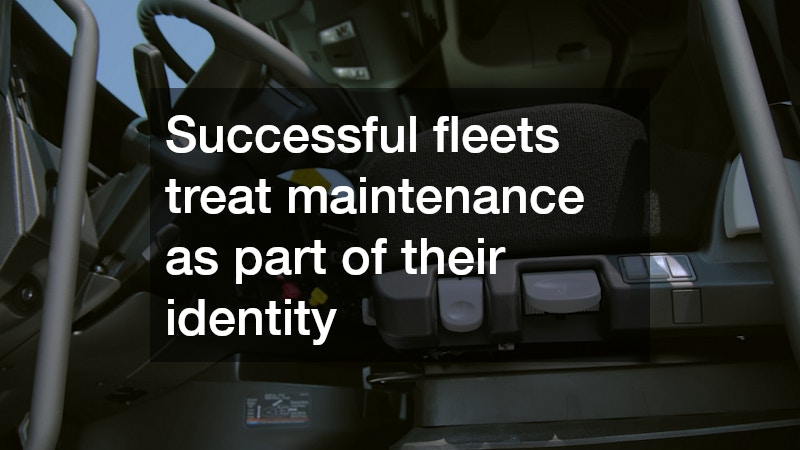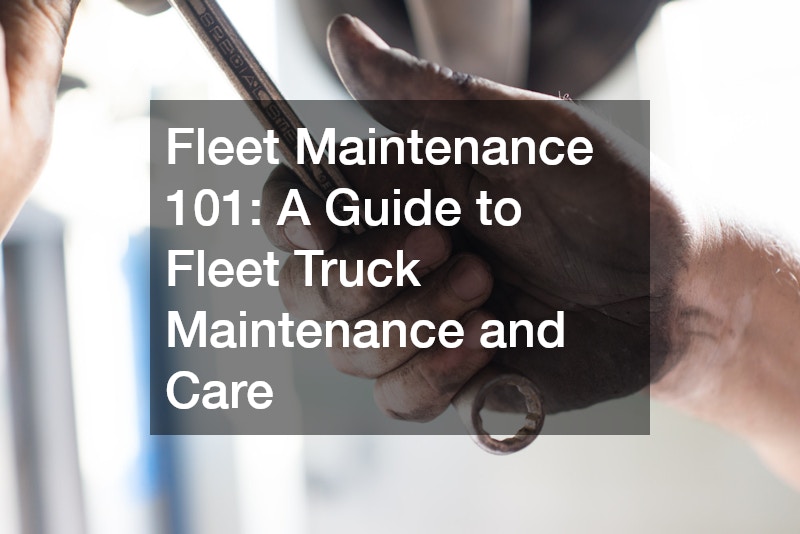Keeping a fleet of trucks on the road is about more than changing oil and rotating tires. Your vehicles carry your customers’ products, represent your brand in every lane, and keep your business cash flow moving. When one unit goes down unexpectedly, it can ripple through delivery schedules, overtime costs, and customer relationships. A thoughtful maintenance strategy helps you reduce those surprises and treat your fleet as the long term investment it really is.
Good fleet care also protects the people who drive and work around your vehicles every day. When trucks are well maintained, drivers have an easier time steering, braking, and managing long hours in changing weather conditions. That makes it less likely that they will be forced into risky decisions because of equipment failures. A strong program shows drivers that their safety comes first, which supports morale and retention.
Finally, a clear maintenance plan gives you more control over costs. Instead of reacting to breakdowns, you can schedule work during slower periods, negotiate better pricing, and budget for big repairs or replacements. Over time, that stability makes it easier to grow, win new contracts, and take on more complex routes. Fleet maintenance becomes not just an expense, but a competitive advantage.
What Fleet Maintenance Really Involves
Many people picture fleet maintenance as a checklist of basic services, but it actually covers a wide range of tasks and decisions. You need to think about inspections, repairs, driver training, and the systems that track everything. When you look at your operation as a whole, it becomes easier to see how each truck fits into the bigger picture of your local fleet. That perspective helps you balance mileage, usage, and service intervals across all of your vehicles.
Beyond hands on work, effective maintenance requires planning, communication, and documentation. Managers need to coordinate with drivers, shop staff, and outside providers so that everyone understands the schedule and priorities. When work orders, inspection reports, and repair histories are organized, you can spot patterns before they become serious problems. That sort of visibility is what separates reactive fleets from those that consistently stay ahead of issues.
Designing A Practical Maintenance Schedule
A good schedule starts with the manufacturer’s recommendations but adjusts for real world use. Trucking in hilly terrain, frequent stop and go driving, or harsh weather can all shorten the life of certain components. When you map out intervals for inspections, lubrication, and replacements, build in time to revisit the plan as your operation changes. That way, your schedule grows with your routes, instead of being stuck in place.
Certain systems deserve special attention because failures can be dangerous or expensive. For example, regular checks of fuel tanks help you spot rust, leaks, and mounting issues that could lead to spills or fires. Those inspections can be tied to refueling routines or major service milestones to make them easier to remember. The more consistently you look at these critical components, the less likely you are to be caught off guard.
A practical maintenance schedule also accounts for downtime and staffing limitations. You may need to stagger service visits so you always have enough vehicles available to cover essential routes. Planning ahead for holidays, peak seasons, and large contracts can prevent situations where too many trucks are out of service at once. When the schedule supports your business rhythm, everyone has an easier time sticking to it.
Caring For Fuel, Fluids, And Powertrain Systems
Clean fuel is essential to keep engines running smoothly and efficiently. Over time, moisture and contaminants can build up, especially if trucks sit unused or refuel at varying locations. Regularly draining water separators, replacing filters, and visually checking fuel tanks can reduce the risk of clogged lines or injector damage. These simple steps can make a big difference in performance and fuel economy.
Transmission health is another pillar of reliable fleet operation. Hard shifts, slipping gears, or delayed engagement are early warning signs that should never be ignored. Building a relationship with a trusted local transmission mechanic gives you a place to turn when those symptoms appear. They can help you decide whether an issue calls for adjustments, a fluid service, or more in depth repairs.
For fleets that cover long distances or run heavy loads, transmission stress can build up quickly. Temperature swings, stop and go traffic, and frequent hill climbs all add to the strain. Having regular checkups with a local transmission mechanic makes it easier to catch problems before they lead to roadside failures. That attention protects both your trucks and your timelines.
Supporting Heavy Loads, Brakes, And Tires
Every mile a truck travels with cargo on board adds wear to suspension, brakes, and tires. When routes involve steep grades, rough roads, or frequent starts and stops, that wear accelerates. Fleets that rely on heavy hauling need to be especially disciplined about inspections for cracks, loose hardware, and unusual noises. Early repairs in these areas can prevent more serious failures that risk both cargo and driver safety.
Specialized trailers, lowboys, and flatbeds used for moving machinery face unique stresses. Loading and unloading equipment, chaining down irregular shapes, and traversing job sites all affect frames, axles, and braking systems. That is why fleets involved in heavy equipment transport often develop detailed inspection checklists tailored to their configurations. Those checklists make sure no critical component is overlooked when trucks come off the road.
Tire care is another critical piece of the puzzle. Proper inflation, rotation, and alignment reduce blowout risk and improve handling. Tracking tread depths and checking for uneven wear patterns allows you to intervene before a tire becomes unsafe. When your tire program is strong, your trucks handle better in rain, snow, and heat, which keeps both drivers and other road users safer.
Comfort Systems And Driver Experience
Drivers spend their workdays in the cab, so comfort and climate control are not luxuries. When the air is too hot, too cold, or poorly circulated, fatigue sets in more quickly and concentration drops. Building regular inspections of compressors, belts, and vents into your schedule makes it easier to plan needed AC repairs before summer hits. That consistency keeps drivers more comfortable and reduces complaints during busy seasons.
Visibility is another key part of driver experience and safety. Routine checks of glass, mirrors, and lighting systems should be part of every pre trip inspection. For example, keeping spare windshield wiper kits on hand makes it simple to swap out streaking or chattering blades. That small investment pays off every time a sudden storm hits and drivers can maintain a clear view of the road.
When drivers see that management cares about the condition of the cab, they are more likely to take pride in the vehicles they operate. Clean interiors, functioning seats, and reliable controls send a message that their time and health matter. Over the long term, that attitude supports better inspections, faster reporting of issues, and less abuse of equipment. Everyone benefits from this shared commitment to care.
Partnering With Outside Repair And Service Providers
Few fleets can handle every task in house, especially as they grow. Choosing the right outside partners is just as important as hiring the right employees. Many businesses rely on a trusted local fleet repair service, to provide overflow capacity, specialized diagnostics, or after hours support. Having that backup helps you cover more ground without overloading your own shop.
When you work closely with a local fleet repair service, you gain access to technicians who see a wide variety of makes, models, and failures. Their experience can help you refine your maintenance schedule and identify recurring issues. Open communication about common problems, parts availability, and turnaround times makes it easier to coordinate repairs around your operating needs. A strong partnership turns outside experts into an extension of your team.
Relationships with equipment and vehicle sellers also matter. Staying in touch with a reputable semi truck dealer gives you insight into new models, warranty updates, and available parts. When a vehicle reaches the point where repairs no longer make financial sense, you already have a contact who can help you evaluate replacement options. That familiarity can streamline the transition from old units to newer, more efficient trucks.
Some fleets also rely on outside operators to move machinery or specialized loads when internal capacity is limited. Partnering with providers experienced in heavy equipment transport allows you to meet customer needs without stretching your own assets too thin. Clear agreements, shared safety expectations, and regular feedback sessions keep these relationships running smoothly and support your overall maintenance strategy.
Managing Breakdowns, Accidents, And Risk
Even the best maintained fleet will face breakdowns from time to time. Mechanical parts can fail without warning, and road conditions are not always in your control. Preparing for those moments is part of responsible fleet management. When a truck involved in heavy hauling stops unexpectedly, the priority is keeping the driver safe and securing the cargo. Having clear procedures and emergency contacts posted in every cab makes that response easier.
Accidents bring another layer of complexity, involving insurance, regulations, and sometimes injuries. Managers need a plan for collecting information, preserving evidence, and communicating with authorities. In serious cases, it may be wise to consult a truck accident lawyer who understands transportation rules and liability questions. Their guidance can help you avoid missteps that might harm your business in the long run.
Legal and financial consequences from collisions can be significant, especially if hazardous cargo or multiple vehicles are involved. Working with a truck accident lawyer early in the process allows you to evaluate exposure, respond appropriately to claims, and improve policies to reduce future risk. Combined with thorough training and strong maintenance practices, this approach helps you protect both your drivers and your company.
Tracking Data, Inspections, And Compliance
Maintenance work is only half done if it is not documented. Inspection reports, repair orders, and parts usage records provide the information you need to make smart decisions about your trucks. Digital tools can make it easier to capture that data in real time and analyze it later. Looking at trends across your local fleet helps you see which components fail most often and where you should focus preventive efforts.
Regulatory requirements add another reason to keep accurate records. Transportation authorities often require proof of inspections, repairs, and driver training. When your documentation is organized, roadside checks and audits become less stressful. Being able to quickly show how you maintain fuel tanks, brakes, and other safety critical systems demonstrates that you take compliance seriously. That reputation can make future interactions with regulators smoother.
Planning Replacements, Upgrades, And Growth
No truck lasts forever, even with the best care. Over time, repair costs, downtime, and parts availability all influence when it makes sense to retire a unit. Maintenance records give you an objective basis for those decisions. When a vehicle’s operating costs rise consistently, it may be time to compare those expenses with the payment on a newer model. Ongoing conversations with your preferred semi truck dealer can help you evaluate timing and options.
As your business grows, you may add routes, drivers, or new types of loads. Each of those changes should prompt a fresh look at your maintenance program. You might need different inspection intervals, new tools, or additional staff to keep up. Building expansion plans around realistic service capacity helps you avoid stretching your operation too thin. Growth is healthiest when it is supported by a strong foundation of care.
Training Drivers And Building A Culture Of Care
Drivers are on the front lines of fleet maintenance every day. They are the ones who hear new noises, feel changes in steering, and notice warning lights first. Training them to conduct thorough pre trip and post trip inspections is one of the most effective steps you can take. When drivers know how to check lights, tires, and key components, they become early warning sensors for the entire operation.
Simple habits, such as replacing worn blades with stocked windshield wiper kits, reporting minor leaks, or noting small vibration changes, all contribute to long term reliability. Encouraging drivers to speak up about these details without fear of blame creates a healthier culture. Over time, that culture reduces surprises on the road and leads to more predictable service needs. Everyone benefits when the whole team feels responsible for equipment care.
Fleet maintenance is not a single checklist or a one time project. It is an ongoing system that touches drivers, technicians, managers, and outside partners. When you design that system carefully, it helps you keep trucks safe, customers satisfied, and schedules on track. Each inspection, repair, and training session adds another layer of protection for your business. The more attention you give to these building blocks, the more resilient your operation becomes.
Successful fleets treat maintenance as part of their identity, not just a cost of doing business. They invest time in planning, communicate clearly with everyone involved, and adjust their approach as conditions change. With that mindset, you can turn routine care into a powerful advantage on the road. In the long run, a thoughtful maintenance program will support your growth, protect your people, and keep your trucks ready for whatever comes next.




